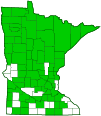tall cottongrass
(Eriophorum angustifolium ssp. angustifolium)
Conservation • Wetland • Description • Habitat • Ecology • Use • Distribution • Taxonomy
Description |
||
Tall cottongrass is a showy, early season sedge. It is native to Europe, western Asia, and North America. It occurs across the northern third of the continental United States from Maine to New York, west to Washington and Oregon, and south along the Rocky Mountains in Colorado and northern New Mexico. In Minnesota it is very common in the wetter northern half of the state, less common in the drier southern half. In the north it is found in many wet habitats, including conifer swamps, edges of marshes and lakes, fens, and ditches. In the south it is found in calcareous fens, sedge meadows, and marshy depressions in prairies. It grows under full or partial sun, usually in peaty soil but sometimes in wet, poorly drained, sandy or loamy soil. It tolerates both acidic soil in bogs and limey (calcareous) soil in fens. Tall cottongrass is an 8″ to 40″ (20 to 100 cm) tall, erect, perennial sedge. It often forms loose colonies. Single stems (culms) rise from a long, creeping, underground, horizontal stem (rhizome). The rhizome is up to 8″ (20 cm) long. The culms are unbranched and slender, 1⁄32″ (1.0 to 1.2 mm) in diameter near the top. They are solid and almost round in cross section. Both basal and stem leaves are produced. Basal and lower stem leaves are up to 16″ (40 cm) long and ⅛″ to ¼″ wide. The blade is flat at the base becoming channeled and triangular in cross section just near the tip. The base of the leaf (sheath), where it wraps completely around the stem, has a dark, reddish tinged band near the top. Upper stem leaves are 1½″ to 4″ (4 to 10 cm) long and 1⁄16″ to 3⁄16″ (2.0 to 4.5 mm) wide. On the uppermost leaf the blade is much longer than the sheath. The inflorescence is a cluster of 3 to 10 stalked spikelets at the end of the culm. Each spikelet is egg-shaped, is ⅜″ to ¾″ (10 to 20 mm) long when in flower, and is subtended by 1 to 3 modified leaves (bracts). The bracts are leaf-like, are dark red at the base, and often have a black sheath. The longest bract is ⅜″ to 4¾″ (1 to 12 cm) long, reaching to or beyond the top of the inflorescence. The central spikelet attaches to the culm without a stalk (peduncle). The remaining spikelets are on 3⁄16″ to ¼″ (5 to 6 mm) long peduncles. The longest peduncles are drooping. Each spikelet consists of 20 to 200 overlapping, spirally arranged scales, each scale with its own flower. The scales are lance-shaped or egg-shaped, 3 ⁄16″ to ⅜″ (5 to 10 mm) long. They have a single prominent midrib that does not quite reach the tip, and no lateral ribs. They are brown to gray at the base, clear at the tip. The flowers are minute. They have no sepals, no petals, 3 stamens, and 1 style. They have numerous hair-like bristles that elongate as the fruit matures, forming a conspicuous cottony tuft. The bristles are ⅝″ to 1 3⁄16″ (15 to 30 mm) long and are usually white, sometimes pale yellowish-brown. When in fruit, spikelets are ¾″ to 2″ (20 to 50 mm) long. The fruit is a dry, black, three angled, 1⁄16″to ⅛″ (2 to 5 mm) long, seed capsule (achene) with one seed. |
||
Height |
||
8″ to 40″ (20 to 100 cm) |
||
Similar Species |
||
Habitat |
||
Conifer swamps, edges of marshes and lakes, fens, sedge meadows, marshy depressions in prairies, and ditches |
||
Ecology |
||
Flowering |
||
Late April to mid-May |
||
Maturing |
||
Late May to early August |
||
Pests and Diseases |
||
|
||
Use |
||
|
||
Distribution |
||||
|
Sources |
|||
| 7/10/2023 | ||||
Nativity |
||||
Native One author (Kartesz, 1999) considers the attribution of Eriophorum angustifolium ssp. angustifolium to North America to be erroneous. |
||||
Occurrence |
||||
Common |
||||
Taxonomy |
|||
| Kingdom | Plantae (Plants) | ||
| Division | Tracheophyta (Vascular Plants) | ||
| Subdivision | Spermatophytina (Seed Plants) | ||
| Class | Liliopsida (Monocots) | ||
Order |
Poales (grasses, sedges, cattails, and allies) | ||
Family |
Cyperaceae (sedges) | ||
| Subfamily | Cyperoideae | ||
| Tribe | Scirpeae | ||
Genus |
Eriophorum (cottongrass) | ||
| Species | Eriophorum angustifolium (common cotton-grass) | ||
Subordinate Taxa |
|||
|
|||
Synonyms |
|||
Eriophorum angustifolium ssp. scabriusculum Eriophorum angustifolium ssp. subarcticum Eriophorum angustifolium ssp. subarcticum var. coloratum Eriophorum angustifolium ssp. subarcticum var. majus Eriophorum angustifolium ssp. subarcticum var. subarcticum Eriophorum angustifolium var. coloratum Eriophorum angustifolium var. giganteum Eriophorum angustifolium var. majus Eriophorum polystachion |
|||
Common Names |
|||
narrowleaf cotton-grass tall cottongrass tall cotton-grass |
|||
Glossary
Achene
A dry, one-chambered, single-seeded seed capsule, formed from a single carpel, with the seed attached to the membranous outer layer (wall) only by the seed stalk; the wall, formed entirely from the wall of the superior ovary, does not split open at maturity, but relies on decay or predation to release the contents.
Bract
Modified leaf at the base of a flower stalk, flower cluster, or inflorescence.
Calcareous
Alkaline; rich in limestone; containing a high proportion of calcium carbonate.
Culm
The hollow or pithy stem of a grass, sedge, or rush.
Peduncle
In angiosperms, the stalk of a single flower or a flower cluster; in club mosses, the stalk of a strobilus or a group of strobili.
Rhizome
A horizontal, usually underground stem. It serves as a reproductive structure, producing roots below and shoots above at the nodes.
Sheath
The lower part of the leaf that surrounds the stem.
Visitor Photos |
|||||
Share your photo of this plant. |
|||||
| This button not working for you? Simply email us at info@MinnesotaSeasons.com. Attach one or more photos and, if you like, a caption. |
|||||
Dan W. Andree |
|||||
I came across these unusual white fluffy plants at Twin Valley Prairie SNA June 8, 2023. They look like they were some kind of plant that maybe bloomed then went to seed like in the photos. |
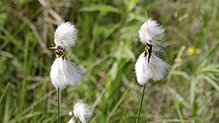 |
||||
MinnesotaSeasons.com Photos |
|||||
Plants |
|||||
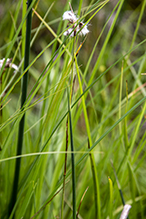 |
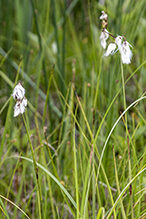 |
||||
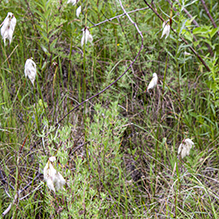 |
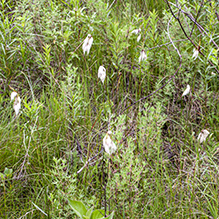 |
||||
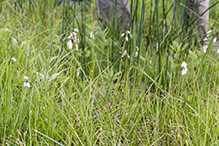 |
|||||
Infructescence |
|||||
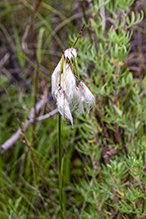 |
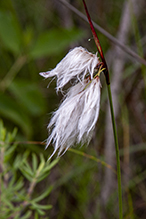 |
||||
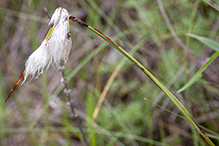 |
|||||

Slideshows |
||
| Eriophorum angustifolium - tall cottongrass Matt Lavin |
||
 |
||
About
Tall cottongrass is a native rhizomatous perennial cottongrass common in wetlands where it often grows in standing water. The inflorescence comprises several pedunculate nodding to drooping spikelets that are subtended by at least two well developed inflorescence (involucral) bracts. The translucent flower bracts lack a prominent midrib or at least a midvein that does not extend to the tip of the bract. |
||

Visitor Videos |
|||
Share your video of this plant. |
|||
| This button not working for you? Simply email us at info@MinnesotaSeasons.com. Attach a video, a YouTube link, or a cloud storage link. |
|||
Other Videos |
|||
| narrow-leaved cotton grass - Eriophorrm angustifolium. Identification and characteristics Coastal Plants of BC - UBC Forestry |
|||
About
Dec 6, 2018 Coastal Indicator Plants of British Columbia. |
|||
| How to Identifu Eriophorum viridi carinatum and angustifolium NY Flora |
|||
About
Nov 11, 2015 |
|||
| Fluffy white heads of Eriophorum angustifolium, common cottongrass in peat meadow NatureFootage |
|||
About
Oct 16, 2019 Largest collection of common cottongrass, peat meadow, Cottongrass, Eriophorum angustifolium, Meadow stock video footage. https://www.naturefootage.com/video-clips/TVG191016_0010/fluffy-white-heads-of-eriophorum-angustifolium--common-cottongrass-in-peat-meadow Fluffy white heads of Eriophorum angustifolium, common cottongrass in peat meadow |
|||
| Common cottongrass (Eriophorum angustifolium) - 2013-06-23 Westdelta |
|||
About
Jun 26, 2013 Eriophorum angustifolium, commonly known as common cottongrass or common cottonsedge, is a species of flowering plant in the sedge family Cyperaceae. Geo location: 52.04958 4.22844 |
|||

Visitor Sightings |
|||||
Report a sighting of this plant. |
|||||
| This button not working for you? Simply email us at info@MinnesotaSeasons.com. Be sure to include a location. |
|||||
| Dan W. Andree 6/8/2023 |
Location: Twin Valley Prairie SNA I came across these unusual white fluffy plants at Twin Valley Prairie SNA June 8, 2023. They look like they were some kind of plant that maybe bloomed then went to seed like in the photos. |
||||
MinnesotaSeasons.com Sightings |
|||||

Created: 7/10/2023
Last Updated:
